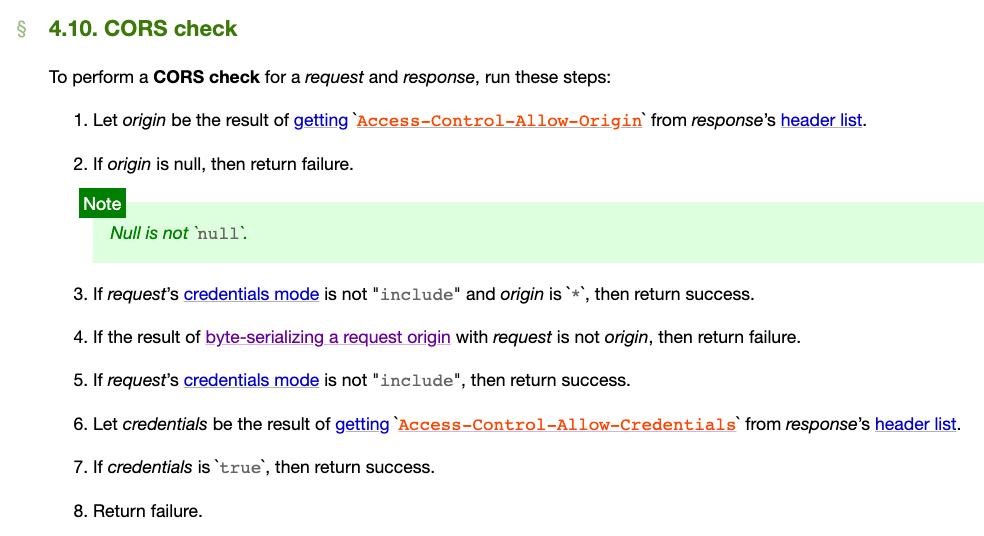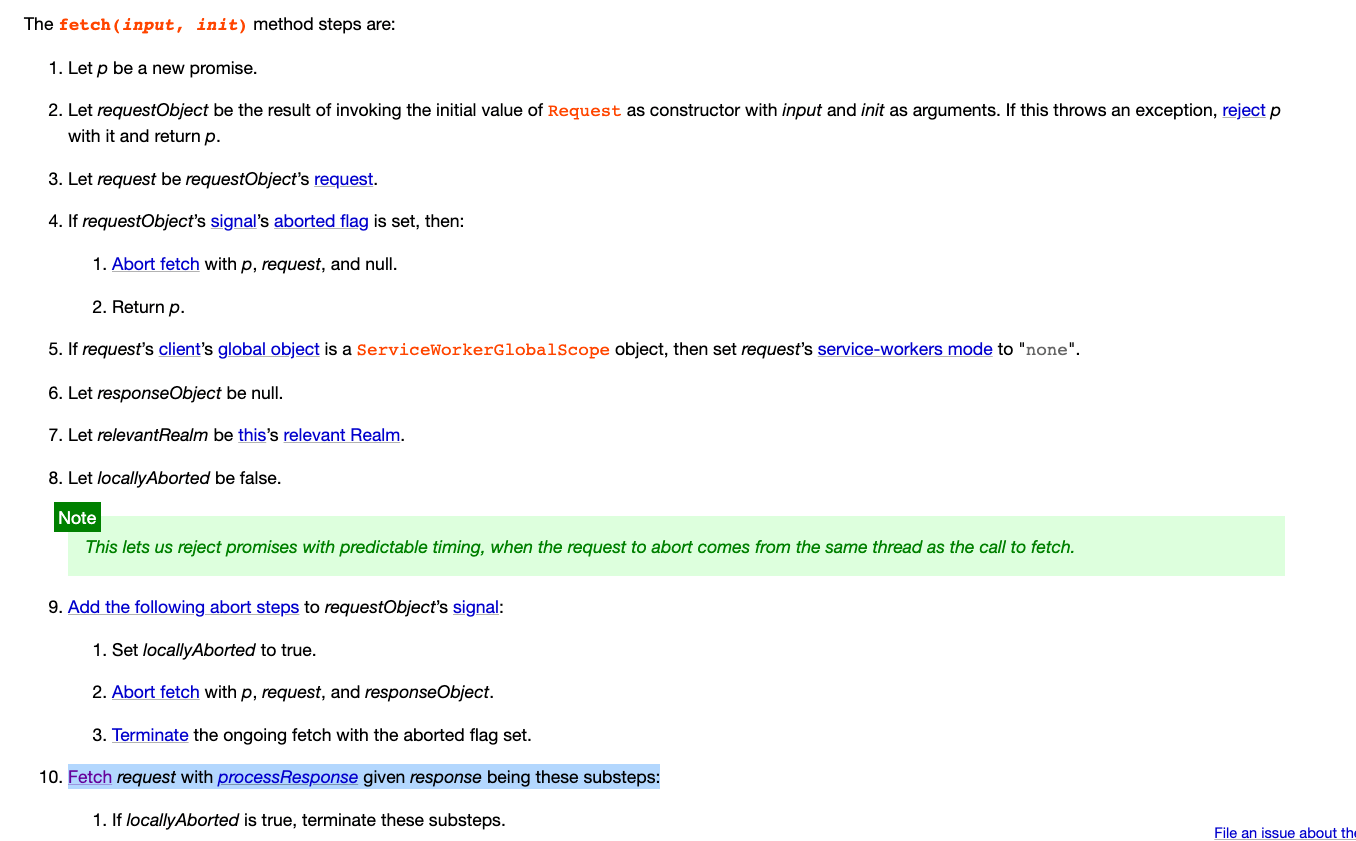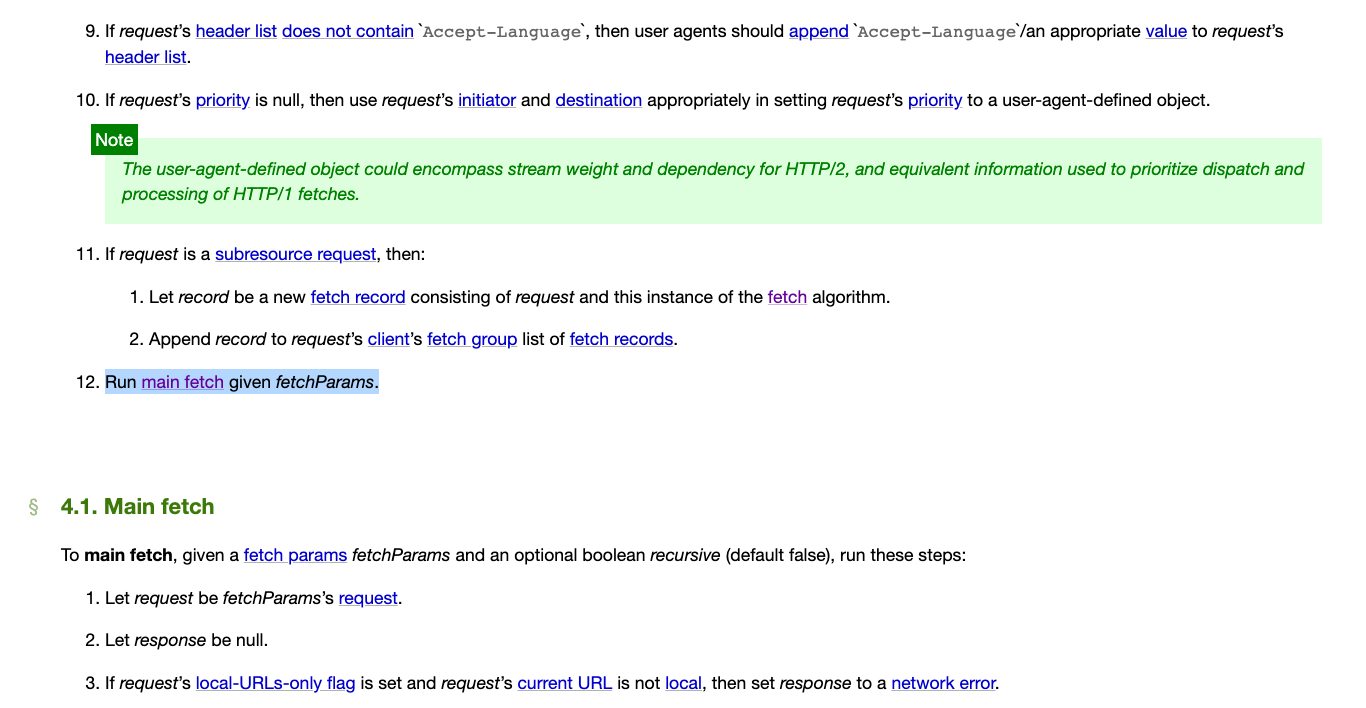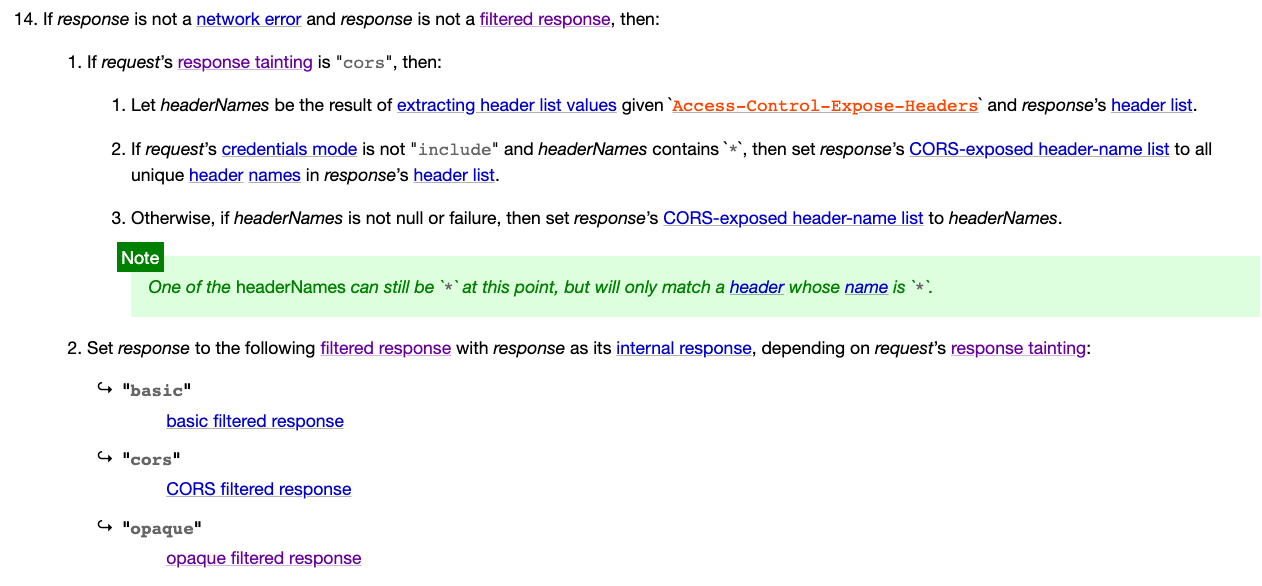前言
當你獲得了一個知識之後,要怎樣才能知道那是正確的還是錯誤的?在程式的領域中這其實是一個相對簡單的問題,只要去確認規範是怎麼寫的就可以了(如果有規範的話)。
舉例來說,JavaScript 的各種語言特性在 ECMAScript Specification 裡面都找得到,為什麼 [] === [] 會是 false,為什麼 'b' + 'a' + + 'a' + 'a' 會是 baNaNa,這些在規範裡面都有,都會詳細說明是用怎樣的規則在做轉換。
而 Web 相關的領域除了 JS 以外,HTML 或是其他相關的規範幾乎都可以在 w3.org 或是 whatwg.org 裡面找到,資源相當豐富。
雖然說瀏覽器的實作有可能跟規範寫的不一樣(像是這篇),但 spec 已經是最完整而且最有權威性的一個地方了,因此來這邊找準沒錯。
如果搜尋 CORS 的 spec,可能會找到 RFC6454 - The Web Origin Concept 以及 W3C 的 Cross-Origin Resource Sharing,但這兩份都叫這一份叫做 Fetch 的文件給取代了。
當初我疑惑了一陣子想說是不是自己看錯,fetch 跟 CORS 有什麼關係?後來才知道原來這邊的 fetch 跟 Web API 那個 fetch 其實不同,這份規格是定義了所有跟「抓取資料(fetch)」有關的東西,就如同它的大綱所寫的:
The Fetch standard defines requests, responses, and the process that binds them: fetching.
這一篇就讓我們一起來看一下 CORS 相關的規範,證明我前面幾篇沒有在唬爛你,講得都是有所根據的。因為規格還滿長的,所以底下就是我挑幾個我認為的重點講而已,想要理解所有的規格內容,還是需要自己去看才行。
(此文章發佈時所參考的規格的版本為:Living Standard — Last Updated 15 February 2021,最新的規格請參考:Fetch)
先來點簡單的
規格這種東西因為很完整所以內容很多也很雜,如果不先從簡單一點的開始很容易會看不下去。而最簡單的就是開頭的 Goals 跟 Preface 這兩個單元了,裡面寫到了:
The goal is to unify fetching across the web platform and provide consistent handling of everything that involves, including:
- URL schemes
- Redirects
- Cross-origin semantics
- CSP
- Service workers
- Mixed Content
RefererTo do so it also supersedes the HTTP
Originheader semantics originally defined in The Web Origin Concept
這份規格統整了所有「fecthing」相關的東西,例如說我們最關注的 CORS 或是其他相關的操作。然後也有提到說這份取代了原本的 RFC6454 - The Web Origin Concept。
接著在前言中有寫到:
At a high level, fetching a resource is a fairly simple operation. A request goes in, a response comes out. The details of that operation are however quite involved and used to not be written down carefully and differ from one API to the next.
fetch 看起來很簡單,不過就是發個 request 然後接收 response 而已,但實際上其實水很深,以前沒有規格記錄下來導致每個 API 的實作都不一樣,這也是為什麼會有這個統一的 spec 誕生。
Numerous APIs provide the ability to fetch a resource, e.g. HTML’s img and script element, CSS’ cursor and list-style-image, the navigator.sendBeacon() and self.importScripts() JavaScript APIs. The Fetch Standard provides a unified architecture for these features so they are all consistent when it comes to various aspects of fetching, such as redirects and the CORS protocol.
這邊提到了我在前面所說的,抓取資料或是跨來源抓取資源並不只侷限在 AJAX 上面,載入圖片或是 CSS 也是抓取資源的一種,而這份規格就是為了統一管理這些行為。
The Fetch Standard also defines the fetch() JavaScript API, which exposes most of the networking functionality at a fairly low level of abstraction.
身為 Fetch 規格,定義 JS 中的 fetch() API 也是相當合情合理的事情。
簡單的部分就到這邊了,這邊就只是在講說為什麼會有這份規格還有它想達成的目的是什麼。
接著我們來看一下 Origin 的定義。
Origin
Origin 的部分在 3.1. Origin header,裡面有附上 ABNF,用特定格式寫成的規則:
Origin = origin-or-null
origin-or-null = origin / %s"null" ; case-sensitive
origin = scheme "://" host [ ":" port ]簡單來說就是 origin 的內容只會有兩種,一種是 "null",注意這邊我特別用引號括住,因為那是一個字串。第二種就是前面文章中提到的 scheme + host + port 的組合。
這邊值得注意的是與舊的 rfc6454 的區別,在舊的規範中 origin 其實可以是一個 list 的:
7.1. Syntax
The Origin header field has the following syntax:
origin = "Origin:" OWS origin-list-or-null OWS
origin-list-or-null = %x6E %x75 %x6C %x6C / origin-list
origin-list = serialized-origin *( SP serialized-origin )
serialized-origin = scheme "://" host [ ":" port ]
; <scheme>, <host>, <port> from RFC
7.2 Semantics
In some cases, a number of origins contribute to causing the user
agents to issue an HTTP request. In those cases, the user agent MAY
list all the origins in the Origin header field不過在新的規範中看起來只會剩下一個。總之呢,origin 的定義就跟我之前講的一樣,是 scheme + host + port 的組合。
再來我們直接去看我們最想知道的 CORS!
CORS
CORS 的部分在 3.2. CORS protocol 的地方。開頭的介紹非常重要。
To allow sharing responses cross-origin and allow for more versatile fetches than possible with HTML’s form element, the CORS protocol exists. It is layered on top of HTTP and allows responses to declare they can be shared with other origins.
CORS protocol 存在是為了讓網頁可以有除了 form 元素以外,也可以抓取跨來源資源的方法。然後這個 procotol 是建立在 HTTP 之上的。
It needs to be an opt-in mechanism to prevent leaking data from responses behind a firewall (intranets). Additionally, for requests including credentials it needs to be opt-in to prevent leaking potentially-sensitive data.
這邊提到了「prevent leaking data from responses behind a firewall (intranets)」,其實就是我第一篇文章中所提到的案例。如果沒有 same-origin policy 的保護,在內網的資訊可能就會被輕易取得。
而「for requests including credentials it needs to be opt-in」也是我們之前所提到的,如果 request 有包含 credentials(通常是 cookie),就必須 opt-in,否則也會有資訊洩漏的風險。
接著底下 3.2.1. General 的這一段也很重要:
The CORS protocol consists of a set of headers that indicates whether a response can be shared cross-origin.
For requests that are more involved than what is possible with HTML’s form element, a CORS-preflight request is performed, to ensure request’s current URL supports the CORS protocol.
這邊提到了兩個重點,第一個是 CORS 是透過 header 來決定一個 response 是不是能被跨來源共享,這就是我在上一篇裡面所說的:
說穿了,CORS 就是藉由一堆的 response header 來跟瀏覽器講說哪些東西是前端有權限存取的。
第二個是如果一個 request 超過 HTML 的 form 元素可以表達的範圍,那就會有一個 CORS-preflight request。
那到底怎樣叫做「超過 form 元素可以表達的範圍」?這個我們稍後再看,先來看底下這兩個部分:
3.2.2. HTTP requests
A CORS request is an HTTP request that includes an
Originheader. It cannot be reliably identified as participating in the CORS protocol as theOriginheader is also included for all requests whose method is neitherGETnorHEAD.
這邊滿特別的,如果我沒有理解錯誤的話,是說一個 HTTP request 如果含有 origin 這個 header,就叫做 CORS request,但這並不代表這個 request 就跟 CORS procotol 有關,因為除了 GET 跟 HEAD 之外的 request 都會帶上 origin 這個 header。
為了驗證這個行為,我建立了一個簡單的表單:
<form action="/test" method="POST">
<input name="a" />
<input type="submit" />
</form>然後 method 那邊 POST 跟 GET 都試試看,發現果真是這樣沒錯。GET 的沒有帶 origin header,但是 POST 的有。所以按照規格上的說法,用表單 POST 送出資料到同一個 origin 底下,也會被叫做 CORS request,奇怪的知識又增加了。
A CORS-preflight request is a CORS request that checks to see if the CORS protocol is understood. It uses
OPTIONSas method and includes these headers:
Access-Control-Request-Method
Indicates which method a future CORS request to the same resource might use.
Access-Control-Request-Headers
Indicates which headers a future CORS request to the same resource might use.
而 CORS-preflight request 就是利用 OPTIONS 來確認 server 是不是理解 CORS procotol。
這邊有一點要特別提,就如同 MDN 上面寫的:
部分請求不會觸發 CORS 預檢。這類請求在本文中被稱作「簡單請求(simple requests)」,雖然 Fetch 規範(其定義了 CORS)中並不使用這個述語
在 Fetch 的規範中並沒有出現簡單請求這個詞,只有區分會不會觸發 CORS-preflight request 而已。
而 CORS protocol 當中的 preflight request 會帶這兩個 header:
- Access-Control-Request-Method
- Access-Control-Request-Headers
來說明之後的 CORS request 可能會用到的 method 跟 header,這我們在上一篇也有提過了。
接著有關 response 的部分:
3.2.3. HTTP responses
An HTTP response to a CORS request can include the following headers:
Access-Control-Allow-Origin
Indicates whether the response can be shared, via returning the literal value of theOriginrequest header (which can benull) or*in a response.
Access-Control-Allow-Credentials
Indicates whether the response can be shared when request’s credentials mode is “include”.
這兩個是針對 CORS request 可以返回的 response header,已經在上一篇文章裡面提到過了。前者用來決定哪些 origin 合法,後者決定是不是允許帶上 cookie 以及設置 cookie。
An HTTP response to a CORS-preflight request can include the following headers:
Access-Control-Allow-Methods
Indicates which methods are supported by the response’s URL for the purposes of the CORS protocol.
Access-Control-Allow-Headers
Indicates which headers are supported by the response’s URL for the purposes of the CORS protocol.
Access-Control-Max-Age
Indicates the number of seconds (5 by default) the information provided by theAccess-Control-Allow-MethodsandAccess-Control-Allow-Headersheaders can be cached.
CORS-preflight request 也是 CORS request 的一種,所以上面所說的針對 CORS request 可以給的 response 也都可以給。
而除此之外還定義了另外三個:
- Access-Control-Allow-Methods:可以使用哪些 method
- Access-Control-Allow-Headers:可以使用哪些 header
- Access-Control-Max-Age:前兩個 header 可以快取多久
這邊值得注意的是第三個,預設值是 5 秒,所以 5 秒內針對同一個資源的 CORS response header 是可以重用的。
An HTTP response to a CORS request that is not a CORS-preflight request can also include the following header:
Access-Control-Expose-Headers
Indicates which headers can be exposed as part of the response by listing their names.
針對不是 preflight 的 CORS request,可以提供 Access-Control-Expose-Headers 這個 header,用來指名有哪些 header 可以存取。
如果沒有明確指定的話,就算拿到了 response 還是沒辦法拿到 header。
接著我們回來看前面提到的那個問題:「怎樣會觸發 preflight request?」
Preflight request
在 4.1. Main fetch 的章節中有詳細敘述了抓取資源的規則,其中我們關注的是第 5 點中的:
request’s use-CORS-preflight flag is set
request’s unsafe-request flag is set and either request’s method is not a CORS-safelisted method or CORS-unsafe request-header names with request’s header list is not empty
- Set request’s response tainting to “cors”.
- Let corsWithPreflightResponse be the result of performing an HTTP fetch using request with the CORS-preflight flag set.
- If corsWithPreflightResponse is a network error, then clear cache entries using request.
- Return corsWithPreflightResponse.
如果 reqeust 的 method 不是 CORS-safelisted method,或是 header 裡面有 CORS-unsafe request-header names 的話,就會設置 CORS-preflight flag 然後進行 HTTP fetch。
繼續往下追的話,在 HTTP fetch 的流程裡會判斷這個 flag 有沒有被設置,有的話就進行 CORS-preflight fetch。
上面所提的東西都可以在 spec 中找到:
2.2.1 Methods
A CORS-safelisted method is a method that is
GET,HEAD, orPOST.
只有這三個 method 不會觸發 preflight。
而有關於 CORS-unsafe request-header names,它會去檢查 headers 是不是都是「CORS-safelisted request-header」,這邊的定義在 2.2.2. Headers 的部分,基本上只有以下幾個會過:
- accept
- accept-language
- content-language
- content-type
但要注意的是 content-type 有額外附加條件,只能是:
- application/x-www-form-urlencoded
- multipart/form-data
- text/plain
這三種。
另外,上面的 header 對應的 value 中一定都要是合法字元,至於哪些是合法字元,每個 header 的定義都不同,這邊就不細講了。
仔細想想其實會發現滿合理的,因為以 form 來說,可以填的 method 就只有 GET 跟 POST(還有一個 dialog 啦但是跟 HTTP 無關了),可以填的 enctype 也只有上面說的那三種,沒有填的話預設就是 application/x-www-form-urlencoded。
因此如果是表單的話,確實不會超過上面那樣的定義。而如果在發出 request 的時候超過了這個範圍,就會送出 preflight request。
所以想要 POST 送出 JSON 格式的資料也會觸發,除非你 content-type 用 text/plain,就可以繞過 preflight request(但不建議這樣做就是了)。
CORS check
關於 request 的部分應該都看完了,接著來看一下 response 相關的部分。有一件我很好奇的事情,那就是該怎麼驗證 CORS 的結果是過關的?
這邊可以看到 4.10. CORS check:

如果 Access-Control-Allow-Origin 裡的 origin 是 null 的話,就失敗(這邊特地強調是 null 而不是 “null”,這我們之後會再提到)。
再來檢查如果 origin 是 * 而且 credentials mode 不是 include,就給過。
接著比對 request 的 origin 跟 header 裡的,不同的話就回傳失敗。
比對到這一步的時候 origin 相同了,接著再看一次 credentials mode,不是 inlcude 的話就給過。
反之則檢查 Access-Control-Allow-Credentials,如果是 true 的話就給過,否則就回傳失敗。
這一系列的檢查有種 early return 的味道在,可能是因為這樣比較好寫成條列式的,盡量把巢狀給壓平。
以上差不多就是跟 CORS 有關的規格了,第六章節整個都在講 fetch API,第七章節在講 websocket。
接著我們來關心一些我覺得也滿重要的一些內容。
誤導人的 no-cors mode 與 fetch 的流程
前面有提過 fetch 可以設定一個 mode: no-cors,接下來我們就來看一下從規格的角度,到底實際上會做一些什麼事情。
因為這是 fetch request 的一個參數,所以要從 5.4 Request class 開始看起,裡面有一個段落是:The new Request(input, init) constructor steps are:
在第 30 步的地方可以看到:

如果 request 的 method 不是 GET、HEAD 或是 POST 的話,就丟一個 TypeError 出來。除此之外,也會把 header's guard 設成 request-no-cors。
上面這只是新建一個 request 而已,接著可以看 5.6. Fetch method 來看實際送出 request 的流程:

前面都只是在設定一些參數,真正做動作的是第十步:
Fetch request with processResponse given response being these substeps
那個「Fetch」是個超連結,點下去可以連到 4. Fetching 的章節,而這邊我們關注的是最後一步:

- Run main fetch given fetchParams.
main fetch 也是一個超連結,點了會跳到 4.1. Main fetch 去,這邊有一整段專門在處理 mode 是 no-cors 時的狀況:

這邊有幾個值得注意的地方:
- 第二步把 request 的 response tainting 設成 opaque
- 第三步去執行了「scheme fetch」
- 第五步新建了一個 response,只有 status 跟 CSP list
- 底下的 warning
這邊可以繼續往 scheme fetch 去追,就會跟剛剛一樣繼續追到各種不同的 fetch method,然後越追越深。不過這邊我已經幫大家追過了,再追下去其實沒什麼特別的,我們先假設第四步不成立好了,所以會執行到第五步:「Return a new response whose status is noCorsResponse’s status, and CSP list is noCorsResponse’s CSP list.」
而 warning 的部分其實滿重要的:
This is only an effective defense against side channel attacks if noCorsResponse is kept isolated from the process that initiated the request.
這邊之所以會新建一個 response,是因為不想回傳原本的 response,要讓原本的 response 跟發起這個 request 的 process 分開。為什麼要這樣做呢?這我們下一篇會提到。
再來我們繼續往下看,可以看到第十四步:

之前已經把 response tainting 設成 opaque,所以根據第二點,會把 response 設成 opaque filtered response。
那這個 opaque filtered response 是什麼呢?
An opaque filtered response is a filtered response whose type is “opaque”, URL list is the empty list, status is 0, status message is the empty byte sequence, header list is empty, and body is null.
這就是我們之前用 mode: 'no-cors' 所拿到的 response,status 是 0,沒有 header,也沒有 body 的 response。
從規格裡面我們證實了我前面所說的事情,一旦 mode 設成 no-cors,你就是拿不到 response,儘管後端有設定 header 也一樣。
使用 CORS 與 cache 時的注意事項
在規格裡面有一個段落:CORS protocol and HTTP caches 特別在講這個。
先假設一個情境好了,那就是 server 只會對有帶 origin 的 request 回覆 Access-Control-Allow-Origin 這個 header,沒有帶 origin 的話就不會回(Amazon S3 就是這樣做的)。然後這個 response 有設定快取,所以會被瀏覽器快取起來。
然後假設我們現在要顯示一張圖片好了,這個圖片在 S3 上面,所以是跨來源的。
我們在頁面上放 <img src="https://s3.xxx.com/a.png">,瀏覽器載入圖片,並且把 response 快取起來。因為是用 img 標籤的關係,所以瀏覽器不會帶 origin header,因此 response 自然而然也就沒有 Access-Control-Allow-Origin。
但接下來我們在 JS 裡面也需要拿到這個圖片,因此我們用 fetch 去拿:fetch('https://s3.xxx.com/a.png'),這時候這就變成是 CORS request 了,因此 request header 會帶上 origin。
可是呢,由於我們前面已經把這個 url 的 response 快取起來了,所以瀏覽器會直接使用之前還沒過期的 cached response。
這時候悲劇就發生了,之前快取的 response 是沒有 Access-Control-Allow-Origin 這個 header 的,所以 CORS 驗證就失敗了,我們就拿不到圖片內容了。
那要怎麼解決這個狀況呢?在 HTTP response header 裡面有一個 Vary,用來決定這個 response 的快取可能會跟著某些 request header 而不同。
舉例來說,如果傳了 Vary: Origin,就代表如果我之後發的 request 裡的 origin header 不同,那就不應該沿用之前的快取。
以前面講的狀況而言,設定這個 header 以後,我們用 fetch 發的 request 因為 Origin header 跟之前用 img 的不同,所以照理來說就不會沿用之前快取好的 response,而是會重新發出一個 request。
而這個問題我本人還真的碰到過…請參考:原來 CORS 沒有我想像中的簡單。
總結
在這篇裡面我們一起看了 fetch 的 spec,從規格的層面去看抓取資源這件事情,也從規格裡面證實了很多前面幾篇文章的說法。其實很推薦大家找一段空閒時間把 spec 稍微掃過一遍,至少會對很多東西有點印象,之後想找資料的時候會容易很多。
除此之外,也能看到一些規格中比較有趣的部分,例如說最後提的那個快取的問題,我還就真的碰到過。如果有早一點看規格,碰到問題時應該就能更快想到解法。
在看規格的時候也可以發現很多東西是出於安全性的考量而做的,接下來就讓我們來看看這個系列的倒數第二篇文章:CORS 完全手冊(五):跨來源的安全性問題。
評論